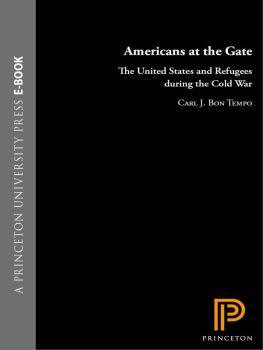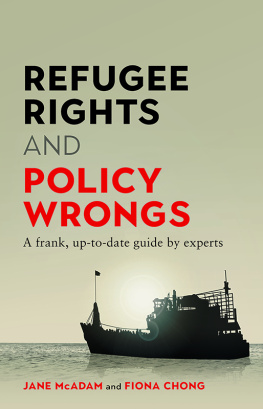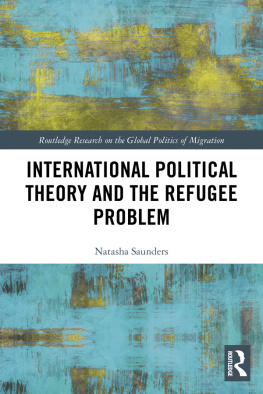
Americans at the Gate
POLITICS AND SOCIETY IN TWENTIETH-CENTURY AMERICA
Series Editors
William Chafe, Gary Gerstle, Linda Gordon, and Julian Zelizer
A list of titles in this series appears at the back of the book
Americans at the Gate
THE UNITED STATES AND REFUGEES DURING THE COLD WAR
Carl J. Bon Tempo
PRINCETON UNIVERSITY PRESS
PRINCETON AND OXFORD
Copyright2008 by Princeton University Press
Published by Princeton University Press, 41 William Street,
Princeton, New Jersey 08540
In the United Kingdom: Princeton University Press, 3 Market Place, Woodstock, Oxfordshire OX20 1SY
All Rights Reserved
LIBRARY OF CONGRESS CATALOGING-IN-PUBLICATION DATA
Bon Tempo, Carl J. (Carl Joseph)
Americans at the gate : the United States and refugees during
the Cold War / Carl J. Bon Tempo.
p cm. (Politics and society in twentieth-century America)
Includes bibliographical references and index.
ISBN-13: 978-0-691-12332-5 (hardcover : alk. paper)
1. RefugeesGovernment policyUnited StatesHistory20th century.
2. Cold War. I. Title.
JV6601.B66 2008
325.21097309045dc22 2008013911
British Library Cataloging-in-Publication Data is available
This book has been composed in Sabon
Printed on acid-free paper.
press.princeton.edu
Printed in the United States of America
10 9 8 7 6 5 4 3 2 1
FOR KRISTIN
Contents
Illustrations
Acknowledgments
IF THIS LIST of thank-yous is long, it is only because numerous institutions, scholars, friends, and family have so generously offered support, encouragement, and advice as I worked on this book.
The staffs of the Truman, Eisenhower, Kennedy, Johnson, and Ford Presidential Libraries were invaluable in aiding my search through their voluminous holdings as I began research. I owe special thanks to Rod Ross at the Center for Legislative Archives who always answered my e-mails and calls about obscure refugee legislation and was ever eager to learn about the project. Thanks as well to the International Rescue Committee, and especially Wynne Boelt and Ed Bligh, for help with photographs.
This book began as a dissertation in the University of Virginias History Department, whose staff and administration were most helpful. I spent a year working at the Miller Center of Public Affairs at UVA where my friends and bosses Marc Selverstone and Garth Wermter gave me the freedom to begin transforming the dissertation into a book. I owe thanks as well to the Centers American Political Development Program for its support. Matt Lassiter was instrumental in bringing me to the University of Michigans History Department as a lecturer in 20042005, where revisions to the book began in earnest. From 2005 to 2007, I taught at the University of Waterloo in Ontario, Canada, and I owe special thanks to my department chairs, Patrick Harrigan and Andrew Hunt, and to the extraordinary administrators Irene Majer and Nancy Birss, for their support. Finally, thanks to Kevin Kruse, Jeremy Adelman, Judy Hanson, and the Princeton University History Department.
Several scholars and friends took time from their busy schedules to answer questions and to read parts of (and sometimes all of) the manuscript. Many thanks go out to Brian Balogh, Erica Gould, Charles McCurdy, Mel Leffler, Michael Parrish, Gary Gerstle, Brian Gratton, M. Isabel Medina, Joe Crespino, Stephen Porter, Lauren Celello, Matt Kilcoyne, Katie Miller, Josh Mester, Linda Zengerle, and Kurt Hohenstein. I also would like to thank the anonymous reviewers who read the manuscript for Princeton University Press for their engaged comments. Brigitta van Rheinberg and Clara Platter at the Press have been especially helpful and supportive of this book.
A whole host of friends helped me to think about the bookand escape from it from time to time. Thanks to Grace, Sarah, and Emma Hale; Chris and Christine; Robert Vinson; Ethan and Zenobia; Pete Flora; John and Cat; Brian Campbell; Andre and Meredith; Kurt and Cory; Scott Matthews; Carrie and Spence; Kate Pierce; Laurie Hochstetler; Derek, Shelley, and Alethia; Joe and Jessica; Jen Ross; Jason Zengerle; Bill and Beth Southern; Andy and Mary Moore; Watson and Susanna; Ally and Abe; Aaron and Meg; Eric Vettel; Leonard Sadosky; Ed and Christina; Cindy Aron; Holly Shulman; Gary and Antoinette; Lynne and David; Ken and Liz; Wendy and Rex; Steven and Leslie; and Dan and Mary Jo.
A special shout-out to my D.C. crew who now actually live all over the country. Most of you have listened to me prattle on about this book at one time or another, so thanks for your patience: Andy and Erin Myers; Pat and Tina Saudek Cusack; Jason and Kristen Southern; Matt Kilcoyne and Jenn Enloe; Peter Glennon; Adam Wenchel and Erin Heath; and Josh and Denise Mester.
My family has been marvelously supportive of this project over the years, and I owe them much thanks: Chris and Katie; Marc; John, Maggie, and Tom Bon Tempo; the Bon Tempos and Glennons of Milford, Massachusetts; Judge Jim Schreier; Mary Kay Schreier; Tom and Marybeth Celello, Dave and Sara Celello, Lauren Celello, and Alison Celello.
Nelson Lichtenstein, who served as my dissertation adviser, has read these pages more times than I can count. His gentle critiques and comments have made this book much better and he and Eileen have been so supportive of both myself and Kristin. I hope that I can be half the scholar, adviser, mentor, and friend that Nelson has been to me over the last decade.
My parents never failed to ask about the progress of the book or to offer encouragement. (My mom even read the manuscripttwice!) They listened to my worries and fears and shared in my successes. At this point, they probably know enough about the publishing process and the academic job market to open their own consulting business. Needless to say, I would not have been able to write this book without their love and support.
And, of course, this book is dedicated to Kristin. It would not have appeared, or possess whatever strengths it might have, without her counsel, support, patience, and love. I learn every day how lucky I am to have her as a partner. Weve had a few adventures over the last few years, and as I write we are embarking on yet another one. I could not imagine sharing itor my lifewith anyone else.
Americans at the Gate
INTRODUCTION
Americans at the Gate
IN THE 1930s, as Europeans fledand attempted to fleethe horrors of Nazism, the United States closed its doors. The United States failure to act as a sanctuary in the face of the most infamous refugee crisis in history makes the next sixty years all the more remarkable. In the decades after World War II, over 4 million refugees entered the United States. To be sure, those 4 million represented only a small percentage of the global refugee population, yet viewed from the perspective of the 1930s, they also represented a significant effort to admit and resettle some of the worlds refugees.
Americans at the Gate explains how and why the United States admitted those refugees. While the United States commitment to refugees certainly grew more capacious over the second half of the twentieth centuryin terms of both the numbers admitted and their countries of originrefugee admissions were by no means ever assured. Rather, Americans battled ferociously over the size, shape, and existence of refugee programs and laws. Opposition existed nationally and it bloomed regionally and locally, especially in places like Florida and California, which saw large influxes of newcomers after 1960. Likewise, refugee admissions rested upon a tricky and shifting calculus of American foreign policy concerns, domestic political and cultural considerations, the nations economic health, the publics receptiveness toward immigrants, and the different ways Americans defined themselves as a nation. As a result, refugee affairs in the United States always have been a distinctly human enterprise, with successes and failures, with mistakes and misunderstandings, and with compassion and miserliness.
Next page







